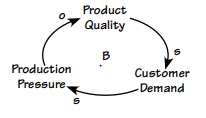Systems thinking is a management approach that focuses on the interrelation of systems and how they operate within the context of larger systems. An excellent example of a system is an organization, as it serves a specific purpose and contains various subsystems such as units. Additionally, as a system, an organization operates within a more extensive system: the environment that influences its functions. Organizations have various projects which they look forward to completing in line with their corporative strategy. Consequently, systems thinking influences projects and corporate strategy development and implementation. This paper demonstrates the value of systems thinking in corporate strategy and describes how an event can develop into a vision or strategy using feedback, loops, and labels.
A system such as an organization fits into a broader context such as the environment. Kim (1999) utilized levels of perspective framework that consists of events, patterns, and systemic structures to illustrate how a system fits in the broader context. According to Kim (1999), events are the daily occurrences witnessed while patterns are the events’ memories that form recurring trends, and systemic structures are the organizations of parts of a system. Consequently, systemic structures generate the patterns and events observed. The same framework can be used to illustrate the connection between systems thinking, projects, and corporate strategy.
Based on the levels of perspective framework, systems thinking generate an organization’s corporate strategy and projects. According to Weissenberger-Eibl et al. (2019), systems thinking helps analyze and assess the factors that influence the development and implementation of corporate strategy. Koral Kordova et al. (2018) state that systems thinking is applied in projects development and implementation to understand complex factors that influence success. The framework also helps understand the relationship between corporate strategy and projects in an organization. According to Liao & Ai Lin Teo (2018), an organization’s strategy dictates the projects to be undertaken and how they are implemented. Therefore, systems thinking influences corporate strategy and projects development and implementation.
Systems thinking plays a crucial role in the development of corporate strategy. Weissenberger-Eibl et al. (2019) illustrated that effective strategy development is only possible when an organization’s internal and external factors are considered. Understanding these factors calls for systems thinking approach and thus contributes to strategy development. Rebs et al. (2019) also stated that systems thinking enables organizations to fully consider their environmental factors when developing their strategy. Specifically, system thinking helps firms undertake systematic screening of their environments and a thorough analysis of the internal circumstances, generating the best strategies.
Many organizations utilize feedback loops to understand the perceptions around significant products or other company-related issues. The feedback enables the transmission and return of information between an organization and other parties, such as the customers (Williams et al. 2017). Feedback loops and labels can illustrate how an event can grow into a vision and later a strategy. Figure 1 below offers an example of how an event can turn into a vision or strategy using loops and labels.

The figure illustrates the relationship between product quality, customer demand, and production pressure. It insinuates that an increase in customer demand increases production pressure, reducing product quality. Therefore, the production pressure that arises from the event, customer demanding more, makes an organization develop a strategy to maintain desirable product quality. High customer demand is likely to make the company develop a strategy such as embracing more technology to avoid lowering product quality.
References
Kim, D. H. (1999). Introduction to systems thinking (Vol. 16). Waltham, MA: Pegasus Communications. Web.
Koral Kordova, S., Frank, M., & Nissel Miller, A. (2018). Systems thinking education—Seeing the forest through the trees. Systems, 6(3), 29. Web.
Liao, L., & Ai Lin Teo, E. (2018). Organizational change perspective on people management in BIM implementation in building projects. Journal of Management in Engineering, 34(3), 04018008. Web.
Rebs, T., Brandenburg, M., & Seuring, S. (2019). System dynamics modeling for sustainable supply chain management: A literature review and systems thinking approach. Journal of Cleaner Production, 208, 1265-1280. Web.
Weissenberger-Eibl, M. A., Almeida, A., & Seus, F. (2019). A systems thinking approach to corporate strategy development. Systems, 7(1), 16. Web.
Williams, A., Kennedy, S., Philipp, F., & Whiteman, G. (2017). Systems thinking: A review of sustainability management research. Journal of Cleaner Production, 148, 866-881. Web.